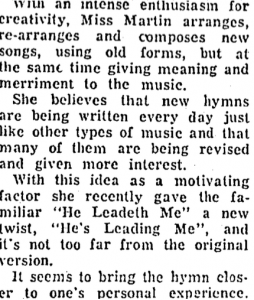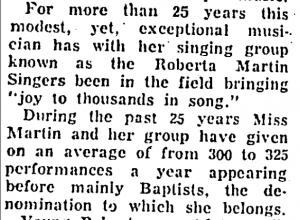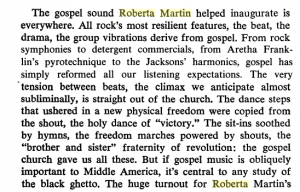Roberta Martin proved that singing was not the only role open to women in gospel music. Her work has inspired many of the gospel genre and always instilled joy and encouragement to her listeners. Let this song play as you read!
In 1933, Roberta Martin and Theodore Frye organised a male quartet with Martin as the accompanist and occasional soloist. By 1936, the group was renamed The Roberta Martin Singers. The group was one of the first featuring male and female singers and soon developed a certain style that was called ‘The Roberta Martin Sound.’ The gospel songs are composed songs but within a clearly discernable gospel performance tradition. Generally, that tradition is more reflective of folk music stylistic traits than distinct compositional techniques, but Roberta Martin’s style of arranging and performing was unique and recognizable. “‘The Roberta Martin sound’ that boasted musical accompaniment of rich harmonies and fluid runs and arpeggios along with falling melodic lines and innovative use of dissonance.” 1
During the 1940’s and 1950’s music, The Roberta Martin Singers were among the best in the country and the group toured the United States and Europe. By 1947, the Roberta Martin Singers had begun their recording career and received multiple Gold Record Awards. 3
One thing that followed through the entire process was Roberta’s drive to give meaning and joy to the music. Consequently, the music the Roberta Martin created influenced many and became a staple for the Afro-American Gospel genre.
What is undoubtedly true is that Roberta and her Singers made a huge contribution to gospel music history. The Gospel sound that Roberta Martin began is everywhere. In the Anthony Heilbut book, The Gospel Sound: Good News and Bad Times, he gives Roberta the credit to the feel of the rock genre. 4
After her death on January 18, 1989, the huge turnout for her funeral was just a small sign of gospel’s hold on its followers. 6 On 15th July 1998 the United States Postal Service issued four 32 cent commemorative stamps honoring four of the queens of gospel music – Mahalia Jackson, Clara Ward, Sister Rosetta Tharpe and Roberta Martin. 7 The Smithsonian was recognizing a woman who was majorly influential as a singer, pianist, composer, choral organizer, arranger, music publisher, and overall advocate for the Gospel tradition.
1 McNeil, William K., ed. Encyclopedia of American gospel music. Routledge, 2013. p. 242.
2 Stone, T. C. (1960, Jan 23). Personality spotlight. The Chicago Defender (National Edition) (1921-1967) Retrieved from http://search.proquest.com/docview/492935100?accountid=351.
3 McNeil, William K., ed. Encyclopedia of American gospel music. Routledge, 2013. p. 242.
4 Heilbut, Anthony. The gospel sound: Good news and bad times. Hal Leonard Corporation, 1975. p, x.
5 Ibid, p, x.
6 Ibid, p, x.
7 McNeil, William K., ed. Encyclopedia of American gospel music. Routledge, 2013. p. 242.
8 Stone, T. C. (1960, Jan 23). Personality spotlight. The Chicago Defender (National Edition) (1921-1967) Retrieved from http://search.proquest.com/docview/492935100?accountid=35.




